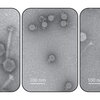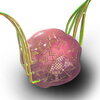
Contact Information
University of Illinois
320 Morrill Hall
505 S. Goodwin Avenue
Urbana, IL 61801
Research Description
Insect social behavior and genomics
Gene E. Robinson is the Director of the Carl R. Woese Institute for Genomic Biology. He holds a Swanlund Chair at the University of Illinois at Urbana-Champaign, where he has been since 1989. He also holds affiliate appointments in the Department of Cell & Developmental Biology, the Program in Ecology, Evolution and Conservation Biology, and the Beckman Institute of Science and Technology. He received his Ph.D. from Cornell University and was an NSF Postdoctoral Fellow at Ohio State University.
Dr. Robinson’s research group uses genomics and systems biology to study the mechanisms and evolution of social life, using the Western honey bee, Apis mellifera, as the principal model system along with other species of bees. The research is integrative, involving perspectives from evolutionary biology, behavior, neuroscience, molecular biology, and genomics. The goal is to explain the function and evolution of behavioral mechanisms that integrate the activity of individuals in a society, neural and neuroendocrine mechanisms that regulate behavior within the brain of the individual, and the genes that influence social behavior. Research focuses on division of labor, aggression, and the famous dance language, a system of symbolic communication. Current projects include: 1) nutritional regulation of brain gene expression and division of labor; 2) gene regulatory network analysis in solitary and social species to determine how brain reward systems change during social evolution; 3) brain metabolic plasticity and aggression; 4) automated monitoring of bee behavior with RFID tags and barcodes; and 5) learning and memory in relation to division of labor. In social evolution, the sophistication of neural and behavioral mechanisms for the essentials of life--food, shelter, and reproduction--stems from increased abilities to communicate and synchronize behavior with conspecifics. Social insects, especially honey bees, are thus exemplars for the discovery of general principles of brain function, behavior, and social organization.
Dr. Robinson obtained his Ph.D. from Cornell University in 1986 and joined the faculty of the University of Illinois at Urbana-Champaign in 1989. He holds a University Swanlund Chair and a Center for Advanced Study Professorship, and since 2001 has served as director of the Carl R. Woese Institute for Genomic Biology (IGB), an interdisciplinary team science institute whose mission is to use genomics to address grand challenges in science and society. Robinson also is co-director of the Bee Research Facility, with former appointments including director of the campus Neuroscience Program and interim dean of the College of Liberal Arts & Sciences. Robinson pioneered the application of genomics to the study of social behavior, led the effort to sequence the honey bee genome, authored or co-authored 350 publications, obtained over $70M in extramural research funding, and has trained over 35 postdoctoral associates and 25 doctoral students, about half with faculty/independent scientist positions in academia, government, and industry. He serves or served on the National Academy of Sciences (NAS) Council Executive Committee, National Research Council Governing Board and Executive Committee, NIH National Institute of Mental Health Advisory Council, Chan Zuckerberg Chicago Biohub Advisory Committee, provided Congressional testimony, and has past and current appointments on scientific advisory boards for companies and foundations with significant interests in genomics.
Dr. Robinson’s honors include: Fellow and Founders Memorial Award (Entomological Society of America), Fellow and Distinguished Behaviorist (Animal Behavior Society), Distinguished Scientist Award (International Behavioral Genetics Society), Guggenheim Fellowship, Fulbright Fellowship, NIH Pioneer Award, Honorary Doctorate (Hebrew University), and the Wolf Prize in Agriculture. He is a member of NAS, the American Academy of Arts & Sciences, National Academy of Medicine, and American Philosophical Society.
Education
B.A., Cornell University
Ph.D., Cornell University (Entomology)
Awards and Honors
Member of National Academy of Sciences
Additional Campus Affiliations
Maybelle Leland Swanlund Endowed Chair, Entomology
Professor, Entomology
Director, Carl R. Woese Institute for Genomic Biology
Professor, Carl R. Woese Institute for Genomic Biology
CAS Professor, Center for Advanced Study
Professor, Biomedical and Translational Sciences at Carle Illinois College of Medicine
Professor, Natural Resources and Environmental Sciences
Professor, Computer Science
Professor, Political Science
Professor, Beckman Institute for Advanced Science and Technology
Professor, Illinois Natural History Survey
External Links
Recent Publications
Goblirsch, M., Hamilton, A. R., Carlson, M., Robinson, G. E., & Adamczyk, J. J. (2025). Dietary consumption of the plant phytochemical, gelsemine, by worker honey bees (Apis mellifera) affects queen bee egg laying. Apidologie, 56(2), Article 29. https://doi.org/10.1007/s13592-025-01151-6
Robinson, G. E., Bliss, R., & Hudson, M. E. (2024). The genomic case against genetic determinism. PLoS biology, 22(2 FEBRUARY), Article e3002510. https://doi.org/10.1371/journal.pbio.3002510
Stuart, S. H., Ahmed, A. C. C., Kilikevicius, L., & Robinson, G. E. (2024). Effects of microRNA-305 knockdown on brain gene expression associated with division of labor in honey bee colonies (Apis mellifera). Journal of Experimental Biology, 227(8), Article jeb246785. https://doi.org/10.1242/jeb.246785
Vernier, C. L., Nguyen, L. A., Gernat, T., Ahmed, A. C., Chen, Z., & Robinson, G. E. (2024). Gut microbiota contribute to variations in honey bee foraging intensity. ISME Journal, 18(1), Article wrae030. https://doi.org/10.1093/ismejo/wrae030
Walden, K. K. O., Cao, Y., Fields, C. J., Hernandez, A. G., Rendon, G. A., Robinson, G. E., Skinner, R. K., Stein, J. A., & Dietrich, C. H. (2024). High-quality genome assemblies for nine non-model North American insect species representing six orders (Insecta: Coleoptera, Diptera, Hemiptera, Hymenoptera, Lepidoptera, Neuroptera). Molecular ecology resources, 24(8), Article e14010. https://doi.org/10.1111/1755-0998.14010

